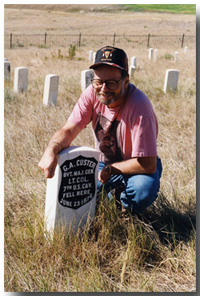|
How did you become interested in the Little Bighorn story?
J. B. I casually picked up a book on the Little Bighorn back in the
early 1970s. A short time after that I found a remainder copy of Graham's
The Custer Myth in a book store, which I bought and read. That one really
intrigued me, so I began to look for other books on the Little Bighorn battle.
Eventually I met Dick Upton, who supplied me with a never-ending stream of LBH
volumes. in a book store, which I bought and read. That one really
intrigued me, so I began to look for other books on the Little Bighorn battle.
Eventually I met Dick Upton, who supplied me with a never-ending stream of LBH
volumes.
Your profession is in the medical field. How did you become interested in
photography and/or the collection of rare photos?
J. B. I actually began with 19th century American historical prints ---
I've collected original Currier & Ives lithographs for over 30 years, and do
research and writing in that field as well. I also took up amateur photography,
so it was only natural that I'd eventually develop an interest in 19th century
photographs. All of these activities are strictly hobbies and have nothing to
do with my "day job," but they provide a nice break from the rigors of full time
medical practice.
What is your most treasured find regarding photographs and why?
J. B.
The most important photo-find is the July 1877 view of the Little Bighorn
battlefield by John H. Fouch, which is the earliest known photograph of the
battlefield, and which had gone undiscovered for 113 years until I had the good
fortunate to acquire it in 1990.
How did the concept of the book, Where Custer Fell, come about?
J. B. After the discovery of the Fouch photograph, and its eventual
publication in "Greasy Grass", I became interested in other early photos of
the battlefield. Looking at one of the views from D.F. Barry's set of photos of
the 10th anniversary observance in 1886, I noticed the remnants of a grave on
Custer Hill. I wanted to see if that grave site correlated to any of the
present markers on Last Stand Hill, and the only way to do that was to set up a
precise modern comparison photo. Doug McChristian, then battlefield historian,
gave me permission to do so in the Fall of 1992, and worked with me to create
those first few then-and-now shots. While the grave in the Barry view did not
correlate to anything in the modern landscape, we reshot a few other historical
photos and made some interesting observations. As we worked, Doug mentioned
that a number of accomplished Custer battle historians had thought of
re-shooting old battlefield views, but none had ever actually launched such a
project. I decided I would.
How long did you and the authors work on the book?
J. B. Starting with that 1992 visit, I returned to the battlefield every
autumn through 2001 to re-shoot historical photos.
Brian Pohanka joined me in 1994, and Sandy Barnard signed on in 1995. Late
each September we'd go up to Montana and attempt to make modern comparison
photos of any newly discovered vintage views that our research had brought to
light over the preceding year. Then these last four years were spent writing
the book.
Was there a specific purpose for the book that you all shared?
J. B. There were several purposes. We learned a lot by walking the
battlefield and creating the modern comparison photos. Recreating a view
requires you to look at both the early photo and the modern landscape much more
closely than you ordinarily would. And as we worked, we developed an admiration
for the photographers who created these images under conditions of great
hardship and danger, and realized the historical value of these views they had
produced. The purpose of this book was to share the importance of these photos
as historical documents, and to focus attention on the photographers who created
them. Historical photographs tend to be under-studied and under appreciated by
historians. In some small way we'd like to remedy that.
What was the process you all followed - research, finding old photos of LBH,
and taking the comparison photos? How did you all divide the work, or did you?
Was Brian the only one to focus on writing the narrative of the battle?
J. B. This was truly a collaborative effort. I may have focused more on
the photo history, while Sandy and Brian looked more at the battle history, but
all three of us were involved in all phases of this book, and each of us read
and critiqued what each other author created. When it came time to decide which
photos to include, we sat down together around my dining room table in San
Pedro. Potential readers will be pleased to know, though, that the battle
history presented in this book was heavily influenced by Brian Pohanka.
How did you all know that you had finally reached the end of the project - or
is it over?
J. B. In my mind, it is not over, and despite the tragic loss
of Brian, Sandy and I hope to go out there and re-shoot photos again, and I've
certainly not stopped gathering historical images to recreate. But by 2001
we had reached a point where we had so much good stuff to share that we knew we had to go ahead
with a book.
(Back
to Top)
|
